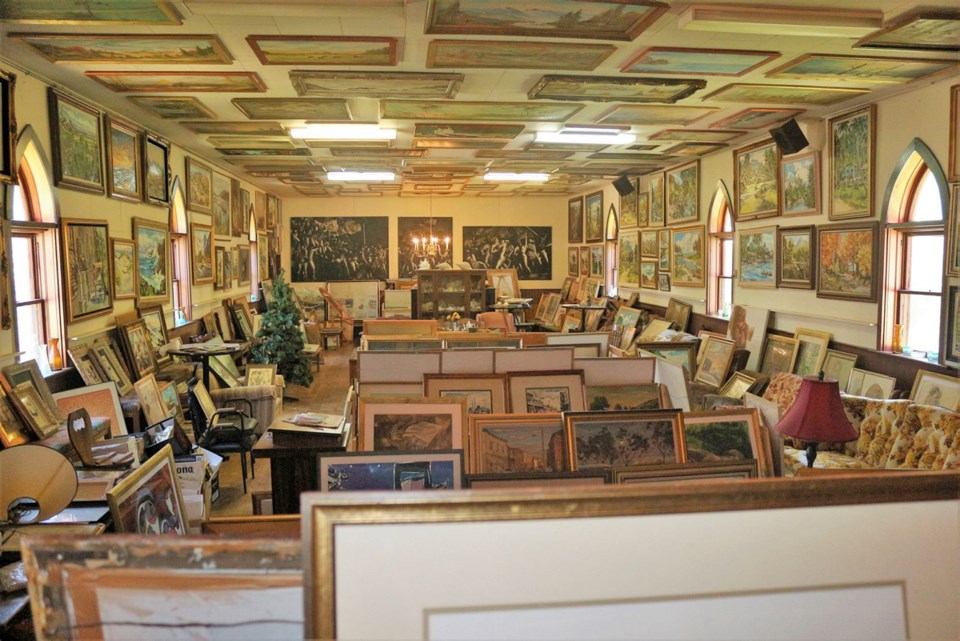 There are so many opportunities to view art that I hardly know which way to turn.
There are so many opportunities to view art that I hardly know which way to turn.
It wasn’t always this way. In the 1930s, Emily Carr held art shows in her dining room at the House of All Sorts on Simcoe Street, and lobbied the city to create an art gallery.
Back then, the annual juried exhibition of the Island Arts and Crafts Society, held at the Willows Fairground was keenly anticipated. In 1946 the Federation of Canadian Artists began to put on art shows in a car showroom on Yates Street. There was no proper gallery here until 1951, when Sara Spenser gave her family’s home to be the Art Gallery of Victoria.
In the mid-1960s, the Point group (which became the Limners) held meetings above the Egoyan’s Furniture showroom on Fort Street. Allan Edwards brought his design studio, the Green Door, to lower Fort Street, and from there launched the careers of Stephen Lowe and Brian Travers-Smith.
Travers-Smith subsequently held sold-out shows regularly in the family home in Oak Bay. With the coming of the Visual Arts Department of the University of Victoria in 1963, generations of professors and graduating artists were unleashed on the city. Bente Rehm opened Pandora’s Box, and Nita Forrest operated the Print Box Gallery in Oak Bay in response to the demand.
The 1970s were great years for the small number of artists who worked here. The few galleries in operation included the Bau Xi (now of Vancouver and Toronto) and Leafhill in the newly restored Bastion Square, as well as Harold Tweten’s shop in Standard Furniture.
Entirely new categories of art showed up in gallery spaces — Tony Hunt’s Arts of the Raven, the Potter’s Wheel in Nootka Court, the Quest for Handicrafts and Alistair MacDuff’s Gallery of the Arctic. The Victoria College of Art took up residence at the Bank Street School, and, later in the decade, Paul Kyle’s gallery provided a home for many of our best professionals.
In the post-Expo ’67 years the sa���ʴ�ý Council and the sa���ʴ�ý NDP government of the early 1970s generously supported the arts. They were golden days, and the Provincial Museum got a splendid new home.
The citizens of Victoria decided they liked buying art, and careers seemed possible for creative people. This time saw the rise of the “parallel galleries,” which provided artist-run spaces for non-commercial ventures. In a building it bought at 510 Fort St., Open Space experimented with “slow-scan” video transmitted by telephone, and XChanges merged studio rentals with a gallery space above a commercial laundry on North Park Street.
Early in the 1980s, the very active Fran Willis Gallery opened on Store Street, next door to Michael Williams’ art-infested Swans Hotel and Pub. These were both popular public fronts for the artists who had invaded the upper floors of most of the buildings in the refurbished Chinatown. The Commonwealth Games shone a light on local production, and art, it seemed, was everywhere.
The democratic approach pioneered by the Moss Street Paint-In launched a fleet of Artists’ Studio Tours, first in Fairfield, then Oak Bay, and later in every neighbourhood from Metchosin to Hornby Island. The Sooke Fine Arts show and then the Sidney Art Show (formerly the Saanich Peninsula Arts Council’s event) continue to attract thousands every year.
With the 1990s, commercial galleries required exclusive contracts from the artists they showed. Robert Vanderleelie and Gunter Heinrich’s Winchester Galleries were soon joined by West End Galleries in this new professional model.
As the university continued to pour out fine-art grads, Deborah Deboer’s Rogue Gallery (in Market Square, then the Eaton Centre, now Deluge Gallery on Yates) gave exposure. With the new millennium, the Vancouver Island School of Art opened on Quadra, and independent spaces such as the 50/50 Arts Collective and the Ministry of Casual Living offered windows for new talent. The Coast Collective in Fernwood and the Coastal Arts Collective in Langford pursued the co-operative model, followed by the Gage Gallery in Oak Bay.
The flood of young artists showed no signs of abating.
In other cities, people like to buy paintings, but here, it seems, everyone wants to make paintings, and the art-supply stores do more business than the galleries. Amid this tsunami of creativity, it has become almost impossible to get the public’s attention.
It used to be that a listing in the weekly newspaper and a few posters would do the job. Not so long ago, artists printed up invitations and put them in the mail. Now, none of that applies.
Today, the savviest artists present a strong online profile. Local artists Chin K. Yuen and Laura Harris are constant presences in my email. Following the lead of the late Robert Genn, some artists post their thoughts almost daily, and offer classes in Mexico and Italy, coupled with yoga and cooking courses.
The Cedar Hill Recreation Centre has two galleries with shows in constant rotation. This summer, Oak Bay continues with painted pianos and an annual sculpture competition, and on Aug. 15 hosts the 13th annual Bowker Creek Brush-up. It has become impossible to keep up with it all.
Now, everyone is a photographer. With painting workshops at Four Cats, and paint-your-own ceramics at the Fired Up! pottery studio, art seems to be easy and fun for everyone. But since modern houses tend to be more windows than walls, where are we to put it all?
The sa���ʴ�ý listings, under the title “At the Galleries,” appears in the Go section of this newspaper every Thursday, and I keep busy dropping in on artists and galleries every week.
Victoria is a magnet for creative people, and there is art everywhere you look.



